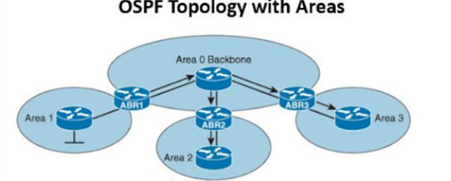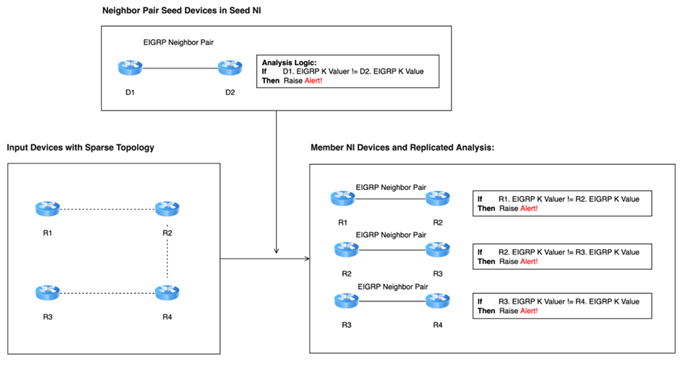Defining Seed Logics
Seed Logics defines the diagnosis logics to be duplicated.
- Click Seed Logics.
- Select one of the diagnosis logics:
- Device-level Logic: used for single device diagnosis
- Neighbor-level Logic: used for neighbor device diagnosis
- Group-level Logic: used for multi device diagnosis
Device-level logic:
- Device-level Logic is used to categorize those devices without cross-device diagnosis into a logic group.
- Each seed logic will only be replicated once for a single device within an Eigen Group.
Example: Checking the configurations for security compliance such as whether the password is encrypted or telnet is disabled, or monitoring the operation status such as interface CRC error.

Neighbor-level logic is used for neighbor-pair devices with cross-device diagnosis. The diagnosis logic will be replicated based on the neighbor pair.
Three types of replication logic designed for the different types of use cases:
- Full Mesh: Each Neighbor-level Logic will be replicated for every two neighbor devices within an Eigen Group.So, if there are n input devices in an eigen group, NIC may generate the maximum of n*(n-1)/2 diagnosis in a member NI. It can be used to check the parameters across each neighbor pair to ensure the parameter is unique.
Example:
Checking router IP for an OSPF autonomous system to ensure that all router IDs configured within the same Autonomous system are unique.

Seed NI checks the router ID of two devices to ensure that they are not the same. If the router IDs are the same, the system will raise an alert.

To expand the logic to all devices within the same OSPF autonomous system, use the Full-mesh replication logic to define the seed logic.
- Sparse Mode: Each Neighbor-level Logic will be replicated by two consecutive neighbor devices within an Eigen Group. So, if there are n input devices, NIC may generate the maximum of n-1 diagnosis in a member NI. Sparse Mode can check the parameters across each neighbor pair to ensure that the parameters are the same across the device selected.
Example: Checking EIGRP K Value for the same EIGRP AS number to ensure all EIGRP key values within the same EIGRP AS number are the same.

Seed NI checks the K value for two devices to ensure they are not the same. If Key Values are not the same, the system will raise an alert.
To expand the logic to all devices within the same EIGRP system, you can use the Sparse Mode replication logic to define the seed logic.

- Hub-spoke Mode: Each neighbor-pair logic will be replicated by the combination of hubs and spokes for the devices within an Eigen Group. So, if there are m P devices and n PE devices, NIC may generate the maximum m*n diagnosis in a member NI.
Example: In a BGP Core network, checking the connectivity between the P device and each of the PE device to make sure the connectivity between them is correct. Then the diagnosis logic can be expanded to other BGP networks with NIC.

Seed NI checks the connectivity between P and PE devices. If there is a connectivity issue between the P and PE devices, the system will raise an alert.
To expand the logic to all devices within the same BGP AS Number, use the Hub-Spoke replication logic to define the seed logic.

- Group-level Logic is used to categorize devices with different roles of certain network design together.
- The logic will be replicated to a single device based on its role.
Example: The compliance check for a typical remote site to 50 more sites with same deployment and setup.
